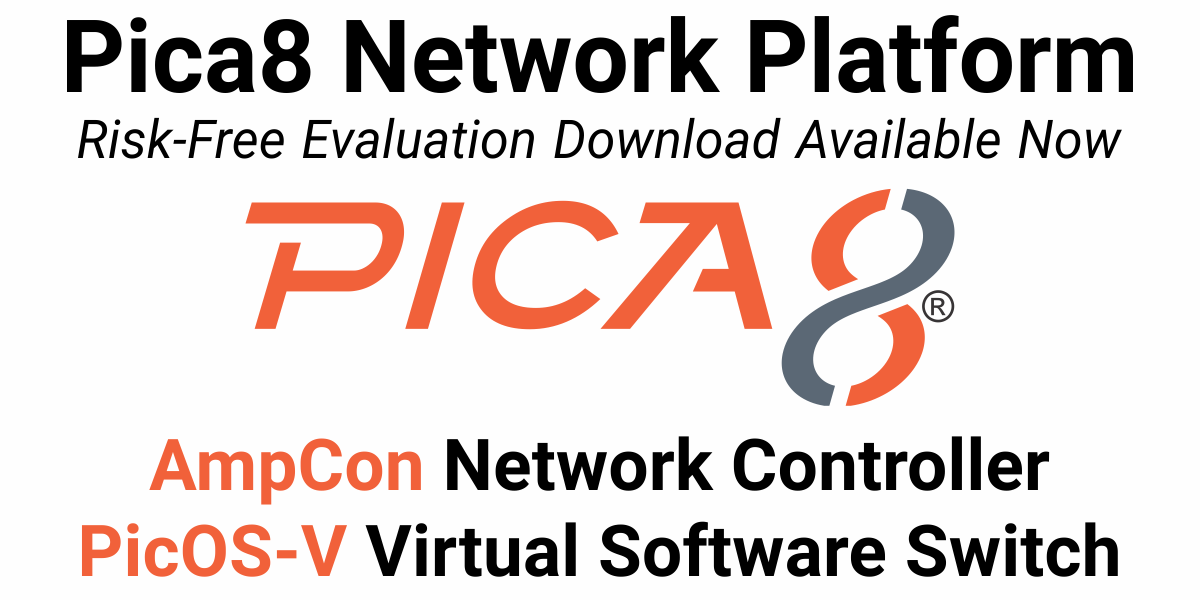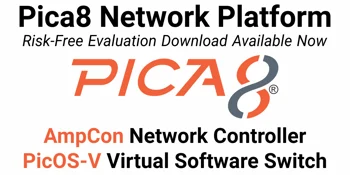Pica8 Network Platform Solution Brief Available Now

I have recently published and made available the Pica8 Network Platform Solution Brief. If you are evaluating whether the Pica8 Network Platform might be appropriate for your networking needs, the solution brief covers all relevant topics of the network platform, including the AmpCon Network Controller, PicOS Software Switch as well as the PicOS-V Virtual Software Switch.
The Pica8 AmpCon Network Controller is a feature-rich automation command center for your enterprise and data center network. It is designed to integrate and work with the PicOS Software Switch, deployed on any industry-standard networking hardware.
 Also available now is the PicOS-V, a free Virtual Machine (VM) from Pica8 that can help you get familiar with the features of the PicOS Software Switch. PicOS-V is used for validating the configuration of PicOS and testing L2 and L3 features at your own pace, at no cost:
Also available now is the PicOS-V, a free Virtual Machine (VM) from Pica8 that can help you get familiar with the features of the PicOS Software Switch. PicOS-V is used for validating the configuration of PicOS and testing L2 and L3 features at your own pace, at no cost:
- Deployment Made Simple: Customer or Prospect can replicate the network by spinning as many PicOS-V Virtual Switches as needed. Pica8 has provided a User Guide on how to do this in GNS3 environment
- Supported On Major Hypervisors: VMware, GNS3 and Virtual Switch
- Free And No License Cost To Use
- Significantly Reduce Deployment Time With Automation: Use it with AmpCon to automate Network configuration and lifecycle management of PicOS-V virtual switches. Pica8 has provided an Evaluation Guide and videos that cover Deployment and lifecycle management of PicOS-V switches.
- Prototype Network Operations Before You Commit: Configuration errors can be corrected and tested without any risk of deploying it for the first time in live network.
- Validate configuration
- Test L2 and L3 features
- Upgrade
- Test automation
- No Bare Metal Hardware Needed: PicOS-V simulates FS, Dell and Edgecore switch models
Follow this link to access the Network Platform Solution Brief directly: https://www.pica8.com/wp-content/uploads/Pica8-Solution-Brief-Network-Platform.pdf
Download, install and evaluate Pica8 Network Platform: https://www.pica8.com/#network-platform
—-
 PicaNotes
PicaNotes
Pica8 has recently released PicOS version 4.0.3. Included with this release are the following features:
- EVPN Multihoming: EVPN multihoming is a replacement mechanism for MLAG in EVPN deployment based on standard protocol (BGP-EVPN). In one customer site, a server can connect to two or more VTEP switches for the redundancy. Additionally, the peer-link between MLAG spines is not needed in EVPN multihoming site. For more details refer to EVPN Multihoming Configuration Guide
- New BGP commands: New BGP commands to configure confederation, dampening, local-preference, fast-external-failover, and prefix limits. For more details refer to BGP Commands.
- BGP Unnumbered: With unnumbered BGP, it’s not necessary to configure IP address of the BGP neighbor. The IPv6 link local is used to build BGP session from one hop to the next hop. The link local address of the BGP neighbor can be discovered by IPv6 ND (Neighbor Discovery) automatically. For more details refer to BGP Unnumbered.
- PicOS Telemetry Interface: gRPC Network Management Interface (gNMI) is a Google Protocol RPC (gRPC) based protocol to manage network devices. The controller or network management system can access to Telemetry Data on the PicOS switch remotely via gRPC gNMI interface to monitor the performance and status of the switch. The gRPC operations including CapabilityRequest, GetRequest, SetRequest, and SubscribeRequest are supported. The telemetry data including interfaces and LLDP are covered. For more details refer to Configuring gRPC gNMI interface for streaming telemetry
- LACP Fast Mode: Under LACP fast mode, LACP control packets are sent to an LACP enabled port 1 per second instead of 30 seconds under slow LACP mode. For details refer to Configuring LACP Fast rate.
—-

Mani Subramanian is Senior Technical Marketing Manager for Pica8.
